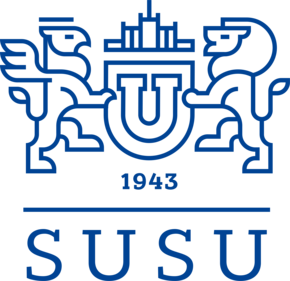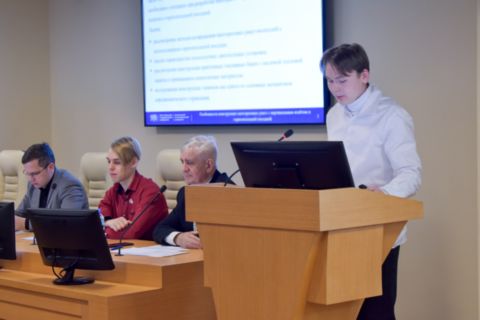Twice a year, the conference reviews students' achievements in experimental and project activities and presents new scientific developments and technologies. Over two days, thirty-three reports from 1st- to 4th-year students and postgraduates were heard at the scientific meeting.
"This is an anniversary conference, we are holding it for the tenth time," said Ruslan Peshkov, Head of the SUSU Laboratory for Launch Vehicles and Unmanned Aerospace Vehicles. "Despite the title specifics, the conference's topics have expanded significantly and cover many tasks, including the design of unmanned aerial vehicles. A distinctive feature of the conference is that 70% of the reports are delivered by junior students, yesterday's applicants. We can conclude that motivated guys, who immediately joined the scientific activities, came to us, to the Aerospace Engineering specialization. The participation of students from the junior courses in project activities within the framework of our Asteroid Youth Design Bureau is bearing fruit. For example, one of our students, already as a postgraduate, is participating in the final of the scientific and technical work competition “Orbit of Youth’, held by Roscosmos; and just recently, as part of a project team, our student has managed to receive a 2nd degree certificate at the 23rd Scientific and Technical Conference for Young Scientists and Specialists of PAO Rocket and Space Corporation “Energia”. All these guys once started at our conference and continue to speak at it today, sharing their experience. We will hold the next such conference in April, before Cosmonautics Day. Schoolchildren, with whom we actively work within the framework of the Sirius.Summer program, will traditionally join us. We will expand the representation of enterprises and academic partners, prepare and publish an indexed collection of conference proceedings, which is already being formed."
This year, at the scientific event, the reports were divided into six thematic sections, including “Designs of Aerospace Products”, “Propulsion Systems of Rocket and Space Products”, “Control Systems of Rocket and Space Products”, “Information Technologies of Rocket and Space Products”, “Power Supply Systems of Rocket and Space Products”, and “Unmanned Aerial Vehicles”.
The topics of the reports included “Analysis of the Possibility of Using an Electric Pump Unit in the Fuel Supply Systems of Launch Vehicles”, “Promising Schemes of Multi-mode Rocket Engines for Space Transport Systems”, “Methods of Protecting the Design of Spacecraft Propulsion Systems”, “Determining the Parameters of the Descent of a Return Vehicle of the “Lifting Body” Class with a Gliding Parachute System”, and many others.
First-year postgraduate student of the Department of Automatic Control Systems at SUSU Yaroslav Romanov told the audience about neural network methods in problems of guaranteed estimation in dynamic systems.
"In control systems, when a specific object moves, it is necessary to evaluate its full state vector," explained Yaroslav. "One way to solve the problem is guaranteed evaluation. While solving this problem, an information set, expressed by a polyhedron, arises. In my research, I consider existing methods for finding this information set using neural networks. I analyse existing methods, identify their shortcomings, and look for ways to eliminate the latter. It turned out that no one had ever used neural networks in guaranteed evaluation problems, and all solutions were achieved only using linear algebra. Now I set myself the goal of developing a neural network model that will look for not only a solution, but also the information set itself."
Varvara Piastolova, a SUSU student majoring in Aerospace Engineering, gave a report on “Engines of Ultra-Small Spacecraft”:
"During the research, I discovered for myself the control device for small and ultra-small class devices, and considered the development prospects that can be investigated and developed in the future. The use of ultra-small spacecraft is very widespread today, and in the future this area will only expand, and therefore it is necessary to improve the existing technologies. This opens up prospects for using such devices in various missions, including asteroid exploration, interplanetary flights and even deep space exploration missions."
Research centres and teams, secondary education institutions, federal and regional ministries and departments of Russia, companies producing aerospace equipment and educational materials, Russian scientists and inventors, teachers, business representatives, postgraduate students, students and schoolchildren were invited to participate in the conference.
The members of the jury for day two were Ruslan Peshkov, Head of the SUSU Laboratory for Launch Vehicles and Unmanned Aerospace Vehicles, Kirill Khazhiakhmetov, Head of the Research Laboratory for Aircraft Propulsion and Power Systems at SUSU, Dmitry Katsay, Associate Professor of the Department of Information and Measuring Equipment, and Nikita Korchak, design engineer at the Research Laboratory for Aircraft Propulsion and Power Systems.
Based on the results of two conferences (the 10th and the upcoming 11th), a collection of reports entitled “Asteroid Safety” will be published in the 2025 academic year and will be included in the Russian Science Citation Index database.
Ekaterina Bolnykh, photo by Ivan Zagrebin




